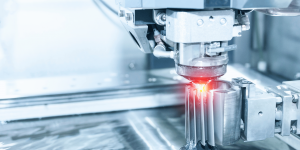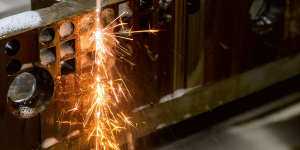EDM est un processus d'usinage à décharge électrique non traditionnelle qui utilise des étincelles électriques pour éliminer le matériau d'une pièce. Presque toutes les industries l'utilisent, y compris l'aérospatiale, médical, automobile, électronique, et bijoux. Cette procédure prend une électrode à fil mince qui est ensuite guidée à travers la pièce. Par conséquent, il est capable de créer des coupes et des formes précises.
L'origine de l'usinage EDM filaire remonte à 1960 Quand il a été développé pour la première fois en Suisse par le Dr. HEURE. Grappe. Au tout début, il était employé pour l'industrie de l'horlogerie. Il a été utilisé pour les coups de poing et les matrices de gravure. Au fil du temps, Les progrès technologiques ont rendu ce processus plus efficace et diversifié. Ainsi, L'usinage EDM filaire est applicable dans plusieurs champs de production.
Avantages et inconvénients de l'usinage EDM filaire
Le fil EDM permet une précision et une précision inégalées, automation, vitesse, et polyvalence. D'abord, Il permet aux ingénieurs de travailler avec des détails de conception complexes avec une haute précision et une précision. L'électrode de fil peut être prédéfinie pour suivre les chemins complexes, La forme de la pièce peut être plus détaillée que ce qui pourrait être réalisé grâce à des méthodes d'usinage conventionnelles.
En plus, L'usinage EDM filaire est capable de traiter des matériaux difficiles comme l'acier durci et le titane. Le processus est sans outil et utilise une technique d'usinage unique qui ne s'appuie pas sur des outils de coupe qui peuvent être usés ou casser, ce qui en fait finalement un processus idéal pour l'usinage des matériaux difficiles ou cassants.

Malgré l'usinage EDM filaire ayant certains avantages, il a également certaines limites. L'un des principaux inconvénients est qu'il utilise une vitesse de coupe plus faible que tous les autres processus d'usinage. Avec l'électrode de fil adoptant une approche basée sur l'érosion, Le temps d'usinage pour des composants plus grands ou des matériaux plus épais dépend du taux d'érosion de l'électrode, qui est un processus plus long.
Comprendre le processus d'usinage EDM Wire
Les concepts de base de l'usinage EDM filaire impliquent l'application de étincelles électriques se procurer du matériel à partir d'une pièce. L'alimentation utilise une impulsion à haute fréquence pour produire une décharge haute tension entre l'électrode filaire et la pièce, ce qui entraîne un chauffage du matériau jusqu'à son point de fusion et de vaporisation. Le matériau fondu est ensuite éliminé par le liquide diélectrique, qui a le double rôle d'un agent de liquide de refroidissement.
Une machine EDM filaire, Dans sa configuration typique, englobe un certain nombre de composants, comme une alimentation, la bobine de fil, le guide de fil, la table de travail, et un système de liquide diélectrique. L'électrode en fil est généralement en laiton ou en cuivre, Et pour éviter la création de toute distorsion, il est en continu par les guides dans une bobine.
Le processus d'usinage EDM Wire comprend la mise en place de la pièce sur la table de travail de la machine, Programmation du chemin de coupe et des paramètres, et démarrer le processus d'usinage. La machine utilise l'électrode de fil qui fait les coupes précises; Ceci est basé sur les instructions préprogrammées.
Facteurs affectant la précision de l'usinage EDM
Il peut y avoir certains facteurs qui pourraient réduire la précision de l'usinage EDM. Les attributs matériels de la pièce sont un facteur principal inclus dans le processus. La conductivité électrique et les points de fusion sont diverses pour différents matériaux, qui peut avoir une grande influence sur la qualité et l'efficacité du processus d'usinage.
Le diamètre et la tension de l'électrode du fil se révèlent également être des facteurs très vitaux déterminant la précision d'usinage. Les fils plus fins permettent des coupes plus délicates avec des tolérances très serrées, mais les ruptures sont plus susceptibles de se produire. Le lien correct du fil est une exigence technique pour maintenir la stabilité et empêcher la flexion pendant l'usinage.
Les paramètres de puissance et de vitesse aideront à préserver la précision et l'efficacité de l'opération. Des vitesses de coupe plus élevées peuvent réduire considérablement le temps de broyage, mais ils peuvent être inadéquats en termes de finition de surface et de précision dimensionnelle. Les paramètres appropriés doivent être réglés pour obtenir une vitesse de coupe souhaitable sans introduire une usure excessive ou des dommages à l'électrode de fil.
Le type de liquide diélectrique utilisé pour obtenir l'usinage EDM filaire a également un effet sur la précision. Les liquides diélectriques jouent un rôle du liquide de refroidissement et rincent des lambeaux pendant l'usinage. Quant au type de liquide diélectrique, des facteurs tels que la viscosité, conductivité, et les capacités de rinçage doivent être prises en compte pour assurer les meilleurs résultats.
Choisir la bonne machine EDM avec vos besoins
Si vous essayez de choisir la machine Wire EDM, Vous devez faire attention à certaines choses. D'abord, Le type de machine EDM filaire doit correspondre aux exigences de l'application pour éviter un décalage. Il y a deux types principaux: Machines EDM en forme de fil et machines EDM à coupe métallique. Deux types de machines EDM filaires sont des machines à coupe métallique et des machines de coupe à fil, qui conviennent à l'usinage à usage général et à haute précision, respectivement.
Avec ça, Il est nécessaire de prendre soin de la capacité de coupe de la machine à souder, précision, et la fiabilité. La capacité de coupe montre la plus grande dimension et épaisseur du matériau. La précision est d'une importance capitale lorsqu'il s'agit de fournir des tolérances étroites, et la fiabilité est celle qui garantit un fonctionnement cohérent et une perturbation minimale.
Les principaux fabricants de machines Wire EDM sont des marques telles que Mitsubishi Electric, Sodick, Fanuc et makino. Ces marques ont une réputation de production d'équipements de pointe avec des fonctionnalités modernes et un fonctionnement stable.
Conseils d'entretien et de dépannage pour les machines EDM filantes
Comme la machine Wire EDM ne peut donner que les meilleures performances et la longue durée de vie, La maintenance de la machine est plus nécessaire. Cela englobe des activités telles que le nettoyage et la lubrification de divers éléments, Vérification de la tension et de l'alignement des fils, et examiner les connexions électriques.
Les principaux problèmes qui peuvent survenir pendant l'usinage EDM filaire peuvent être une rupture de fil, Mauvaise finition de surface, et des inexactitudes dimensionnelles. Souvent, Les défauts de fil sont dus à l'exagération de la tension, mauvais placement, ou guides usés. En conséquence d'un réglage de puissance incorrect ou d'un coup d'insuffisance, La finition de surface peut être médiocre. L'insuffisance des dimensions du fil est l'un des facteurs qui peuvent provoquer des inexactitudes dimensionnelles comme la déviation du fil ou une mauvaise programmation.

Les éléments suivants sont des précautions de sécurité essentielles lors de l'utilisation de machines WeDM. Les travailleurs doivent utiliser des EPI comme des lunettes de sécurité et des gants pour éviter un contact nocif avec des matériaux nocifs. La machine doit être bien fondée pour éviter tout risque électrique, et tous les verrouillages de sécurité correspondants doivent être installés et opérationnels.
Applications de l'usinage EDM filaire dans diverses industries
Merci à la précision et à la polyvale, Cette technologie est utilisée dans différents secteurs industriels pour créer des formes compliquées. Dans l'industrie aérospatiale, Son application comprend la fabrication de lames de turbine, pièces de moteur, et les détails des cadres d'avions.
Dans l'industrie médicale, CNC COUPE est utilisé pour produire des instruments chirurgicaux, implants, et composants de dispositifs médicaux. Sa haute précision et sa capacité à travailler avec des matériaux biocompatibles en font l'outil parfait pour la conception de ces équipements.
L'industrie automobile comprend l'usinage EDM filaire dans sa production de moules, outils, et décède pour la construction de véhicules. La méthode est utilisée pour fournir la possibilité de fabriquer des pièces complexes et précises requises dans plusieurs aspects des usines automobiles modernes.
Wire Edm est une technique qui découvre, interconnexion, et crée des microélectrodes, connecteurs, et d'autres petits composants avec de très petites tolérances dans l'industrie de l'électronique. Il peut être utilisé sur les matériaux conducteurs; ainsi, Il est idéal pour la fabrication de composants électroniques.
L'industrie des bijoux utilise également l'usinage CNC Wire EDM, qui permet la fabrication de modèles et de conceptions exquis dans des métaux précieux. Le processus permet aux bijoutiers de développer des pièces uniques et personnalisées avec la plus grande précision.
L'usinage EDM câblé est un processus d'usinage multiples et précis qui a ses utilisations dans de nombreuses industries. L'utiliser aide à fabriquer des formes complexes avec une grande précision. C'est ce qui en fait un outil très important dans la fabrication moderne. Ce type de processus, cependant, a ses avantages – Par exemple, l'option de travailler avec n'importe quel matériel, Peu importe à quel point c'est dur, Et pour créer des détails précis. Cependant, il a également un certain nombre de contraintes, y compris les vitesses de coupe lentes.
